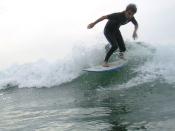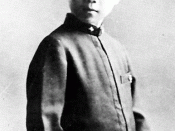Yukio Mishima was an author who wrote with graphic detail and imagery. He used this technique to further his storylines and themes. Imagery is the incorporation of the senses in a story so that the reader feels more connected to the book. In his book, The Sailor Who Fell From Grace With The Sea imagery was used in the last paragraph to enhance the relationship between the sea and Ryuji, and also used to foreshadow Ryuji's "return" to the sea, two themes that are seen throughout the book.
The battle between a life of honor on the seas, or a life with the woman Ryuji loves, is described throughout the book. Ryuji had always ridiculed other shipmates who settle down and start a family. Then, he does the same thing, by asking Fusaka to marry him and becoming Noboru's future stepfather. Noboru and his gang find this very dishonorable and wish to return Ryuji to the sea.
As they are leading him up the mountain, Ryuji notices that the boys were like "six tugboats laboring futilely to tow a freighter out to sea" (170). Ironically, Ryuji does not notice that he is the freighter. Mishima used imagery in that sentence so that the reader could see this in his mind clearly. Imagery, in this instance, also represents the sea. Mishima characterizes the water "with spring still far away was Persian blue except where the shadow of one pearly cloud turned it pale, chilly white" (174). Yukio intended the white spot to be Ryuji, a missing part of the sea. Once Ryuji returns, the white spot will be gone, and he will take its place.
Yukio also uses imagery to foreshadow future events. By the middle of the book, it is inferred that Ryuji will die at the end. During the...


